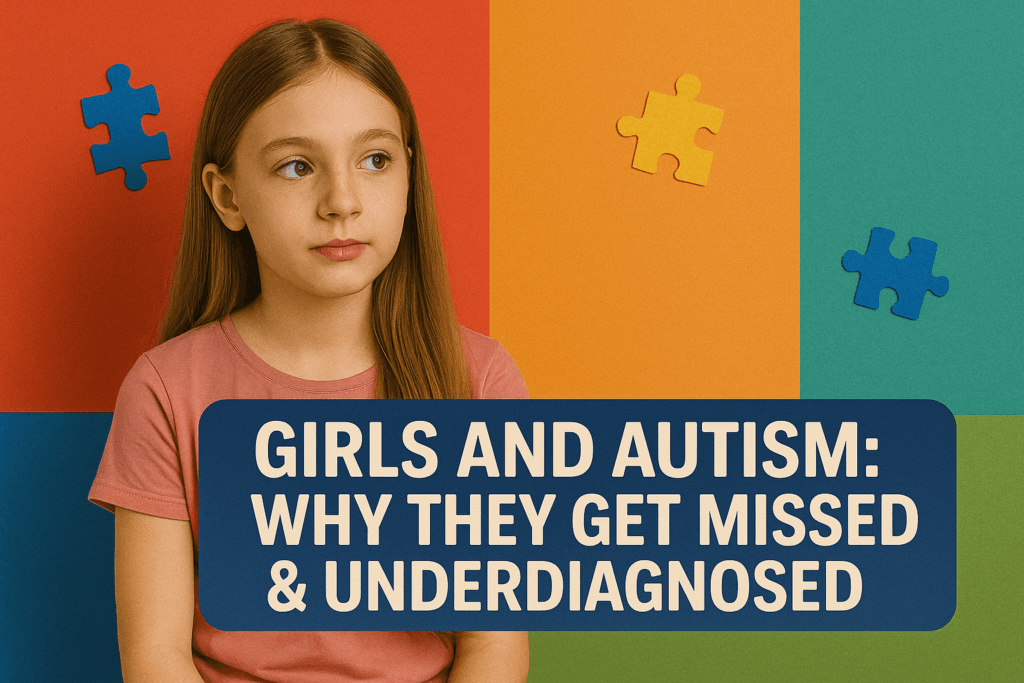🌟 Introduction: Autism in Girls is Often Overlooked
When we think of autism, many people still imagine the classic behaviors seen predominantly in boys. But autism in girls often looks different—so different, in fact, that it frequently goes undiagnosed until later in life. This article explores why this happens, how autism manifests in girls, and what we can do to support them better.
🧠 Understanding Autism in Girls: What Makes It Different?
The presentation of autism in girls tends to be more subtle, often leading professionals and parents to miss the signs. Here’s how autism in girls might differ from boys:
| Characteristic | Boys | Girls |
|---|---|---|
| Social Behavior | May avoid eye contact, show less interest in friendships | May mimic others, try hard to “fit in” |
| Interests | May fixate on one specific topic (e.g., trains, numbers) | May have intense interest in socially typical topics (e.g., animals, books) |
| Communication | More apparent delays in speech or language | May use advanced vocabulary but struggle with context |
🌈 Important: Just because a girl is sociable doesn’t mean she doesn’t have autism.
🎭 The Art of Masking: A Hidden Challenge
One major reason autism in girls is missed is masking—the act of camouflaging autistic behaviors to blend in socially.
💔 Consequences of Masking:
- Mental exhaustion
- Anxiety and depression
- Identity confusion
- Late or missed diagnosis
🧩 Girls might force themselves to make eye contact, memorize social scripts, or mimic peers—making their autism nearly invisible to teachers, family, and even clinicians.
👩⚕️ Why Diagnosis is Often Delayed
Autism in girls is typically diagnosed 2-3 years later than boys. Some are diagnosed only in adulthood.
Reasons for Delay:
- Diagnostic criteria are male-biased 🧍♂️
- Teachers and doctors may lack training on how autism looks in females
- Girls may not exhibit disruptive behaviors
- Co-occurring mental health conditions (like anxiety) may overshadow autism
📊 Real Stories, Real Impact
Let’s look at a few anonymized examples that reflect the spectrum of autism in girls:
- 👧 “Maya, 8, loved animals and spoke eloquently, but struggled deeply with social rules. She was labeled ‘shy’—until a psychologist identified autism.”
- 👩 “Priya, 26, was diagnosed after years of anxiety and burnouts. She says understanding her autism changed her life completely.”
These stories are not rare—just underreported.
📚 Educational & Social Support: What Helps
Early intervention can make a world of difference for girls with autism. Key strategies include:
🧩 Tailored Interventions
- Speech and language therapy
- Social skills training
- Occupational therapy
🧑🏫 Classroom Strategies
- Encourage flexible, inclusive activities
- Don’t force eye contact
- Allow quiet zones and downtime
🤝 Social Support
- Help them find neurodiverse-friendly peer groups
- Validate their experiences
- Educate parents and teachers about autism in girls
🧬 Hormonal and Biological Influences
Some researchers suggest hormonal, genetic, or immune system differences may help explain why autism in girls appears differently.
🔬 For example:
- Estrogen may play a protective role
- Girls may require a higher genetic “load” to express autistic traits
- Different brain connectivity patterns are observed in studies
🧠 Emotional and Mental Health Considerations
Because girls are often undiagnosed or misdiagnosed, they may suffer silently for years.
Common Emotional Challenges:
- Depression
- Eating disorders
- Anxiety
- ADHD
🧡 Early recognition of autism in girls can prevent mental health crises later in life.
🛠️ Diagnosis Tools That Work Better for Girls
Some newer assessment tools and approaches can help identify autism in girls more accurately:
- Girls Questionnaire for Autism Spectrum Conditions (GQ-ASC)
- ADOS-2 with gender-adapted scoring
- Clinical interviews focused on masking and social fatigue
👩⚕️ Ask for assessments that consider social camouflaging and gender-specific traits.
🧩 How Can Parents Help?
Here are simple yet powerful ways parents can support their daughters:
- Be observant—notice patterns, not just isolated incidents
- Don’t dismiss sensory sensitivities or meltdowns as “drama”
- Advocate strongly in schools and medical settings
- Celebrate neurodiversity in your household 💛
🗣️ Raising Awareness: Change Starts With Understanding
The world is just beginning to recognize how autism in girls differs. More inclusive research, diagnostic tools, and awareness campaigns are needed.
🎗️ Share resources, support campaigns, and normalize discussions around neurodiversity.
❤️ Support Autism Wings Inc.
At Autism Wings Inc., we believe in creating holistic support systems for children with autism—including nutritional education, therapy, and soon, a dedicated school!
We’re currently raising funds to build a specialized Autism School that nurtures every aspect of development.
👉 Donate Now
📌 Visit us: www.autismwings.com
🔚 Conclusion: It’s Time We See the Whole Spectrum
Girls with autism have long been under the radar. With increased understanding and tailored support, we can help them thrive as their authentic selves—not masked versions of what the world expects.

